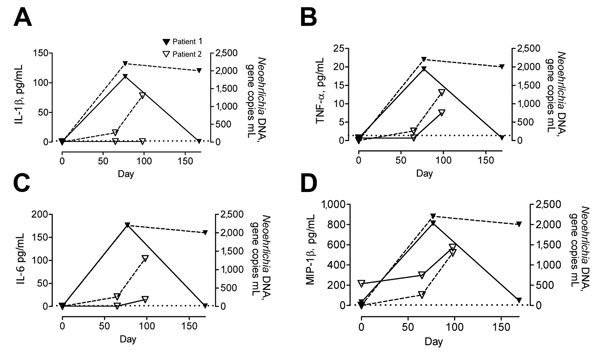Volume 21, Number 8—August 2015
Dispatch
Infections with Candidatus Neoehrlichia mikurensis and Cytokine Responses in 2 Persons Bitten by Ticks, Sweden
Figure 1

Figure 1. Proinflammatory cytokines in 2 patients infected with Candidatus Neoehrlichia mikurensis, Sweden. Concentrations of cytokines A) interleukin-1β (IL-1β), B) tumor necrosis factor-α (TNF-α), C) interleukin-6 (IL-6), and D) macrophage inflammatory protein-1β (MIP-1β) were measured in serum of patient 1 on days 0, 77, and 169 and in serum of patient 2 on days 0, 65, and 98. A rash developed in patient 1 on day 77 and in patient 2 on day 65. Dashed lines indicate levels of Neoehrlichia DNA in plasma for both patients. Dotted lines indicate detection limit for each cytokine.
1These authors contributed equally to this article.
Page created: July 15, 2015
Page updated: July 15, 2015
Page reviewed: July 15, 2015
The conclusions, findings, and opinions expressed by authors contributing to this journal do not necessarily reflect the official position of the U.S. Department of Health and Human Services, the Public Health Service, the Centers for Disease Control and Prevention, or the authors' affiliated institutions. Use of trade names is for identification only and does not imply endorsement by any of the groups named above.